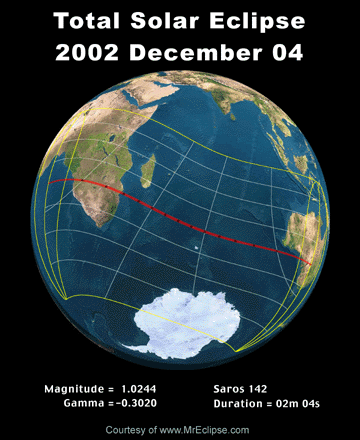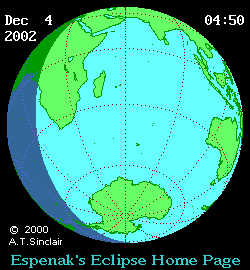|
The final event of the year is a total
solar eclipse visible from a narrow corridor that traverses the Southern
Hemisphere. The path of the Moon's umbral shadow begins in the South
Atlantic, crosses southern Africa and the Indian Ocean and ends at
sunset in southern Australia. A partial eclipse will be seen within the
much broader path of the Moon's penumbral shadow, which includes most of
Africa, western Australia and Antarctica
The umbra carves out a 50 kilometers wide
path as it sweeps across Angola, briefly straddling the Angola/Zambia
border, crosses eastern Namibia before entering northern Botswana. The
umbra crosses completely into Zimbabwe before entering northern South
Africa. The northern third of Kruger National Park is plunged into
totality which lasts 1 minute 25 seconds. Quickly crossing southern
Mozambique, the shadow leaves the Dark Continent and begins its long
trek across the Indian Ocean.
During the next hour and a half, no land
is encountered as the eclipse track curves to the northeast and begins
to narrow. In the final ninety seconds of its terrestrial trajectory,
the umbra traverses South Australia. The coastal town of Ceduna lies at
the center of the 35-kilometer wide path. Totality lasts 33 seconds
while the Sun stands 9¡ above the western horizon. The accelerating
ground speed of the umbra already exceeds 5 km/s. In the remaining
seconds, the increasingly elliptical shadow sweeps across 900 kilometers
of the Australian Outback.
A detailed report on this eclipse is
available from NASA's Technical Publication series (see: NASA Solar
Eclipse Bulletins). Additional information is also available at the 2002
total solar eclipse web site:
http://sunearth.gsfc.nasa.gov/eclipse/TSE2002/TSE2002.html


Animation of
Total Solar Eclipse of 2002
December 04
Fred Espenak


This animation shows the path of the Moon's umbral and penumbral
shadows during the total solar eclipse of 2002 December 04. The
Universal Time is displayed in the upper right corner as the animation
runs. The instantaneous duration of the total eclipse is displayed in
the lower right corner.
The eclipse begins as the Moon's penumbral shadow touches down in the
equatorial Africa (04:51 UT). The penumbra appears as a large greyish
region that sweeps across the Earth from west to east. It is
approximately 4,300 miles (6900 km) in diameter. Everyone located within
the penumbra's path will see a partial eclipse of the Sun on December
04. Outside the path, no eclipse is visible.
About one hour later (05:50 UT), the Moon's dark umbral shadow
appears as a tiny black dot at the center of the penumbra. The umbra is
only about 54 miles (87 km) wide as it rushes across the Earth at
velocities of 1250 miles per hour (2000 km/hr) or more. To see the total
eclipse of the Sun, one must be located in the narrow path of umbra.
Because the umbra is so small and is moving so quickly, the total
eclipse lasts no more that 2 minutes 4 seconds from any location along
its entire path.
From start to finish, the penumbra takes a little over five hours to
sweep across the Earth. The umbra takes just over three hours to travel
from the South Atlantic, through southern Africa and the Indian Ocean
before leaving the Earth's surface in southern Australia.
|